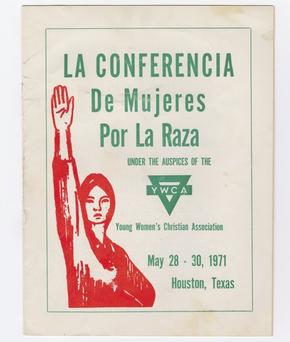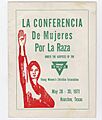Conferencia de Mujeres por la Raza facts for kids
The Conferencia de Mujeres por la Raza (also known as the National Chicana Conference) was a special meeting held in Houston, Texas, from May 28 to May 30, 1971. This conference was the first time that Mexican-American women who supported equal rights came together from all over the country. They met to talk about important issues for feminism and for Chicana women. The Corpus Christi Caller-Times newspaper called it the first conference of its kind.
What Was the Conference About?
The conference happened at the Magnolia Park YWCA in Houston. It was part of the International Decade for Women. Chicana women often faced three types of unfair treatment: racism (being treated unfairly because of their race), classism (being treated unfairly because of their social class), and sexism (being treated unfairly because they are women). The conference aimed to discuss these problems.
Before this big national meeting, smaller groups had met to start planning. The main organizer was Elma Barrera. Other important organizers included Yolanda Garza Birdwell and Gloria Guardiola. Anglo (white) women working at the YWCA also helped plan the event. There was a mix-up about places to stay, so many women from outside Houston didn't have a place to sleep.
More than 600 Chicana women attended the conference. People who came included local community members, activists, students, and even nuns. About 80 percent of the women were between 18 and 23 years old, mostly college students. Groups like La Raza Unida Party, labor unions, the Mexican American Youth Organization (MAYO), and Las Hermanas also attended.
On the first day, workshops talked about topics like education, marriage, religion, and how women were treated unfairly in the Chicano community. On the second day, discussions focused on how Chicana women fit into the larger movement for women's freedom.
The Walkout
On the third day, about half of the people attending the conference left. This was called a walkout. They felt the meeting should focus on racism instead of sexism. The group was also upset that the conference was held in a place they saw as a "Gringo" (a term for a non-Latino, often American) institution.
The walkout began while Bertha Hernandez was speaking. Those who left continued their own meeting at a nearby park. There, they created their own ideas and plans. Some workshops on the third day were canceled because of the walkout.
Some women at the conference felt that talking about women's issues would divide the movement. Others were bothered by the presence of white women. The walkout showed how Chicana feminism was still developing. The women who walked out argued that Chicanas should not hold the conference at the YWCA because it was run by "gavachas" (another term for non-Latino women). Many attendees also felt they weren't involved enough in planning the conference. They also thought the workshops weren't achieving much. Anna NietoGomez described the walkout as a disagreement between Chicana feminists and those who were more loyal to the broader Chicano movement.
Because of this split, attendees had two sets of ideas to review. The plan was for everyone to look at these ideas before the second Conferencia de Mujeres por La Raza. Then, different communities could give their opinions, and a vote would happen at the next conference in 1972.
Why Was It Important?
The conference brought up the topic of feminism within the Chicano community. It led to ideas that supported women's rights. These ideas spoke out against machismo (a strong sense of male pride and dominance), unfair treatment in education, and different rules for men and women. They also questioned the strict rules of the Catholic Church that affected women.
The conference showed the growth of a national movement for Chicana women's rights. Ideas were also created about the importance of childcare centers. The conference helped show the different ideas and challenges within the new movement for Chicana feminism. It helped a strong group of Chicana women become leaders for others.
After the conference, many more articles were written about Chicana issues. Elma Barrera has continued to share her experiences from the conference.
The Lucy R. Moreno Collection at the University of Texas at Austin has materials and newspaper clippings from the conference.
Images for kids
See also
 In Spanish: Conferencia de Mujeres por la Raza para niños
In Spanish: Conferencia de Mujeres por la Raza para niños



